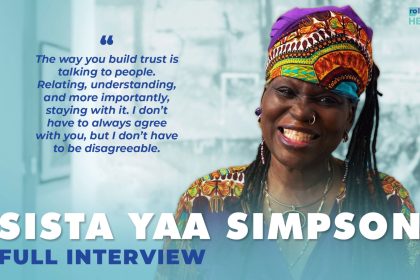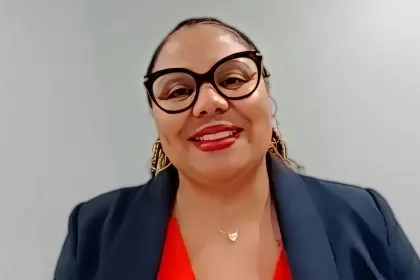For Dr. Shantesica Gilliam, the disturbing statistics on Black maternal mortality aren’t just numbers, they represent lives disrupted and families forever changed. As an assistant professor in Spelman College’s Environmental Health Science Department, Gilliam has pioneered a revolutionary approach to addressing the crisis through education, research, and student empowerment.
“Black women are 3 to 4 times more likely to die from childbirth compared to white women,” Gilliam explains during a recent Health IQ interview. “That statistic isn’t new, but there is now a lot of media coverage around it.”
What is new, however, is Gilliam’s innovative method for preparing the next generation of health advocates, a course called “Foundations of Maternal and Child Health: Prioritizing the Black Body,” which was developed in unprecedented collaboration with Spelman students themselves.
Bridging critical gaps between academia and community
When Dr. Gilliam arrived at Spelman College two years ago, she noticed an immediate interest from students about maternal health issues, albeit with limited knowledge. This observation sparked what would become a groundbreaking educational initiative.
“Research is a way to tell stories to the academic community,” Gilliam says. “It’s a way for us to bring about voice for people who are in our communities and people who are impacted by these health issues.”
The disconnect between academia and community has long plagued public health efforts. Gilliam identifies 5 key elements that make her approach revolutionary:
- Student-driven curriculum development that gives future leaders agency over their education
- Interdisciplinary appeal that attracts students from mathematics, computer science, and political science
- Health equity focus that examines maternal health through lenses of advocacy and community engagement
- Representation in research to build trust within Black communities
- Direct community involvement that breaks down traditional academic silos
This comprehensive strategy addresses what Gilliam describes as a fundamental issue: “Things feel siloed. We have our community, we have our people who are out working in the community. Then we have our academic institutions, our researchers, our teachers, our medical providers, and sometimes it doesn’t feel like we’re all together.”
Student collaboration transforms education
What makes Gilliam’s course truly remarkable is the unprecedented level of student involvement in its creation. After hosting community dialogues with students, complete with pizza and gift card incentives, Gilliam selected five teaching assistants from diverse academic backgrounds to help design every aspect of the curriculum.
These students, Chelsea Tamara Benton, Michelle Washington, Naya Bournes, Talia Ford, and Jaisha Williams, created the syllabus, selected readings (including Dorothy Roberts’ “Killing the Black Body”), designed assessments, and established a book club component.
“Our students had a voice on what they wanted to learn,” Gilliam emphasizes. “With that they were able to have some type of agency over their education, and to know that they can also have a say in what they want to learn.”
The collaborative approach reflects Spelman’s motto, “A Choice to Change the World.” As Gilliam observes, her students “hold that heavy to their heart. They feel like what happens to one Black woman happens to another, and they really want to make a difference.”
Representation matters in research and education
For communities historically mistreated by medical research, most infamously in the Tuskegee syphilis experiment, trust remains a significant barrier to participation. Gilliam understands that representation is essential to rebuilding that trust.
“It’s very important for Black women to conduct research and be the face of research, so that we can instill some type of trust into our communities,” she explains. “A lot of people do not trust research due to the historical injustices that we’ve seen.”
By placing Black women at the forefront of both research and education, Gilliam’s approach creates pathways for authentic community engagement while preparing students to become trusted practitioners themselves.
This representation extends to the academic setting as well, where Spelman’s unique position as a historically Black women’s college creates an educational environment where students can “understand the science behind maternal and child health” while also understanding “the lived experience of marginalized communities.”
Personal motivation drives professional passion
Though Gilliam didn’t have family members who died from childbirth, she witnessed complications that sparked her interest in maternal health research. That personal connection now fuels her professional commitment, particularly during challenging times.
“I always tell my students that they’re the reason why I keep going every single day,” Gilliam shares. “If there’s a time where I just feel like I’m not motivated, where things are feeling too heavy… I think about my students.”
This dedication becomes especially important given current political realities. “We know that there is an attack on public health right now, which also means that there will be an attack on maternal child health and the initiatives around that,” Gilliam acknowledges. “Things do feel just a bit heavy and a bit scary, but I think about my students, and I can’t [give up].”
Creating sustainable change through education
As Gilliam’s first cohort of students progresses through the innovative course, they represent the beginning of what she hopes will become “a small army of young women” prepared to address maternal health disparities. The curriculum’s design ensures that future Spelman students will benefit from this groundbreaking approach for years to come.
“At a time where we know that Black maternal mortality is this national crisis, it is critical that our students, who are future public health leaders, politicians, clinicians, are prepared to be able to address these issues,” Gilliam emphasizes.
By creating a course that centers Black women’s experiences and empowers students to shape their own education, Gilliam is advancing Spelman’s mission while addressing an urgent public health crisis. Her approach recognizes that sustainable solutions require both academic rigor and authentic community connection, a powerful combination that offers hope for reducing maternal mortality rates in Black communities.
For Gilliam, watching students embrace this work brings profound satisfaction. “It’s so empowering! It’s fulfilling,” she says. “It’s just empowering to be able to empower them.”
Through innovative education, collaborative research, and a deep commitment to community engagement, Dr. Gilliam and her students at Spelman College are creating a new model for addressing maternal health disparities, one that may ultimately save countless lives.














